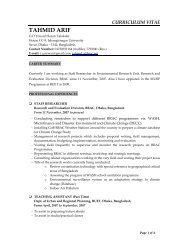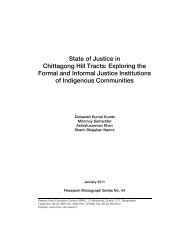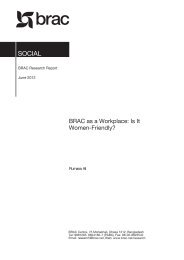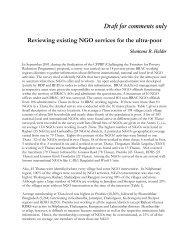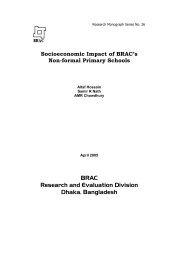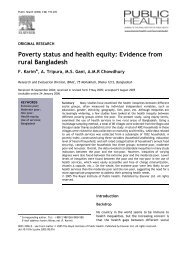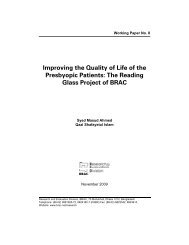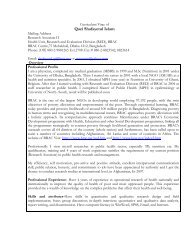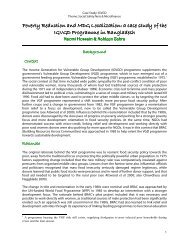Combining health and social protection measures to reach the ultra ...
Combining health and social protection measures to reach the ultra ...
Combining health and social protection measures to reach the ultra ...
You also want an ePaper? Increase the reach of your titles
YUMPU automatically turns print PDFs into web optimized ePapers that Google loves.
Access <strong>to</strong> <strong>health</strong><br />
Intergovernmental Panel on Climate Change (IPCC) 38<br />
concludes that climate change can result in significant<br />
ecosystem disruptions <strong>and</strong> threatens substantial damage <strong>to</strong><br />
<strong>the</strong> earth’s natural systems. In addition, several authors have<br />
argued that maintaining a certain level of biodiversity is<br />
necessary for <strong>the</strong> proper provision of ecosystem goods <strong>and</strong><br />
services 39-42 . The Millennium Ecosystem Assessment warns<br />
that <strong>the</strong> ongoing degradation of ecosystem functions poses a<br />
growing <strong>health</strong> risk 43 . Several ecosystem functions are<br />
important <strong>to</strong> sustain our physical <strong>health</strong>. First, ecosystems<br />
provide us with basic human needs like food, clean air, <strong>and</strong><br />
clean water. Second, <strong>the</strong>y prevent <strong>the</strong> spread of diseases<br />
through biological control. Finally, ecosystems provide us with<br />
medical <strong>and</strong> genetic resources, which are necessary <strong>to</strong><br />
prevent or cure diseases 44 .<br />
Globalization <strong>and</strong> proximal <strong>health</strong><br />
determinants<br />
Figure 2 shows that <strong>the</strong> impact of globalization on each<br />
proximal <strong>health</strong> determinant is mediated by <strong>the</strong> abovediscussed<br />
changes in distal fac<strong>to</strong>rs. The most important<br />
relationships will be discussed in more detail below.<br />
Health services<br />
Health services are increasingly influenced by globalizationinduced<br />
changes in <strong>health</strong> care policy, economic<br />
development <strong>and</strong> trade, <strong>and</strong> knowledge, but also by<br />
migration. Although WHO aims <strong>to</strong> assist governments <strong>to</strong><br />
streng<strong>the</strong>n <strong>health</strong> services, government involvement in <strong>health</strong><br />
care policies has been decreasing <strong>and</strong>, subsequently, medical<br />
institutions are more <strong>and</strong> more confronted with <strong>the</strong> neo-liberal<br />
economic model. According <strong>to</strong> Collins 45 , populations of<br />
transitional economies are no longer protected by a<br />
centralized <strong>health</strong> sec<strong>to</strong>r that provides universal access <strong>to</strong><br />
everyone <strong>and</strong> some groups are even denied <strong>the</strong> most basic<br />
medical services.<br />
The increasing trade in <strong>health</strong> services also has some<br />
profound implications. Although it is perceived as improving<br />
<strong>the</strong> consumer’s choice, some developments are believed <strong>to</strong><br />
have long-term dangers, such as establishing a two-tier<br />
<strong>health</strong> system, movement of <strong>health</strong> professionals from <strong>the</strong><br />
public sec<strong>to</strong>r <strong>to</strong> <strong>the</strong> private sec<strong>to</strong>r, inequitable access <strong>to</strong><br />
<strong>health</strong> care <strong>and</strong> <strong>the</strong> undermining of national <strong>health</strong><br />
systems 9,11 . The illegal trading of drugs <strong>and</strong> <strong>the</strong> provision of<br />
access <strong>to</strong> controlled drugs via <strong>the</strong> Internet are potential<br />
<strong>health</strong> risks 46 . In addition, <strong>the</strong> globalization process can also<br />
result in a “brain-drain” in <strong>the</strong> <strong>health</strong> sec<strong>to</strong>r as a result of<br />
labour migration from developing <strong>to</strong> developed regions 47 .<br />
However, increased economic growth is generally believed <strong>to</strong><br />
enhance improvements in <strong>health</strong> care. Increased<br />
(technological) knowledge resulting from <strong>the</strong> diffusion of<br />
information can fur<strong>the</strong>r improve <strong>the</strong> treatment <strong>and</strong><br />
prevention of diseases.<br />
Social environment<br />
One central mechanism that links <strong>the</strong> <strong>social</strong> environment <strong>to</strong><br />
<strong>health</strong> is “<strong>social</strong> support”, <strong>the</strong> transfer from one person <strong>to</strong><br />
ano<strong>the</strong>r of instrumental, emotional <strong>and</strong> informational<br />
assistance 48 . Social networks <strong>and</strong> <strong>social</strong> integration are<br />
closely related <strong>to</strong> <strong>social</strong> support 49 <strong>and</strong>, as a result,<br />
globalization-induced changes in <strong>social</strong> cohesion, integration<br />
<strong>and</strong> interaction can influence <strong>the</strong> degree of <strong>social</strong> support in<br />
a population.<br />
Ano<strong>the</strong>r important fac<strong>to</strong>r in <strong>the</strong> <strong>social</strong> environment is<br />
violence, which often is <strong>the</strong> result of <strong>the</strong> complex interplay of<br />
many fac<strong>to</strong>rs. WHO 50 argues that globalization gives rise <strong>to</strong><br />
obstacles as well as benefits for violence prevention. It<br />
induces changes in protective fac<strong>to</strong>rs like <strong>social</strong> cohesion,<br />
Economics<br />
Global markets<br />
Globalization<br />
process<br />
Socio-cultural<br />
Global communication &<br />
diffusion of information<br />
global mobility<br />
cross-cultural interaction<br />
Institutional<br />
structures<br />
Global governance<br />
Health policy<br />
<strong>health</strong>-related<br />
policy<br />
Economic<br />
development<br />
trade<br />
Health<br />
services<br />
–<br />
Socioenvironmental<br />
lifestyle<br />
Population<br />
<strong>health</strong><br />
Knowledge<br />
<strong>social</strong><br />
interactions<br />
Physical living<br />
environment<br />
food & water<br />
Ecosystem<br />
goods <strong>and</strong> services<br />
Global<br />
environmental<br />
change<br />
Environmental<br />
Contextual<br />
determinants<br />
Distal<br />
determinants<br />
Proximal<br />
determinants<br />
Figure 2: Conceptual framework for globalization <strong>and</strong> population <strong>health</strong> 2<br />
070 ✜ Global Forum Update on Research for Health Volume 4




